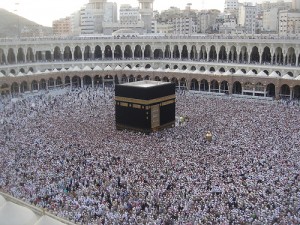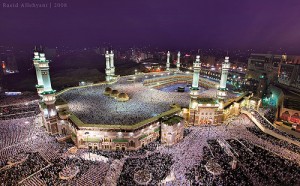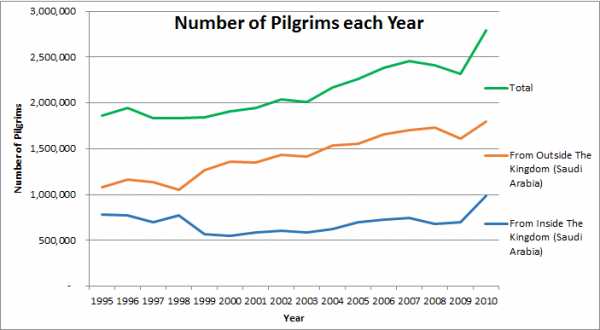The Hajj
History of the Hajj:
The Hajj started around the year 2000 B.C.E. with Ishmael, the son of the prophet Abraham. Abraham exiled Ishamel, who was only an infant at the time, and his mother Hager into the desert. After wandering in the desert for days, Hager and Ishmael had run out of food and water and were slowly dying. In a final attempt to save her son, Hager ran back and forth between the hills of Safa and Marwa. After her seventh attempt to find water, the Angel Gabriel appeared and touched the ground. Miraculously, a well of water appeared, which today is known as the Well of Zamzam. With the instructions of Allah, Abraham built the Kaaba, or “the House of Allah,” at the site of the Well of Zamzam. Abraham began to go every year to this site to perform the Hajj, and his descendants continued this tradition. As time went on, the Hajj became progressively more Pagan: people started to write poetry on the Kaaba as well as have poetry competitions during the Hajj, others sacrificed animals and poured the blood and hung the flesh from the Kaaba, and others performed the Hajj naked. Order was finally restored when the Prophet Mohammed performed what is known as the first official Hajj in 630 C.E. In order to prevent future discrepancies, the Prophet described what should and should not be done in the Koran.
Stages of the Hajj:
The Hajj begins on the8th day of the 12th month on the muslim lunar calendar, or theDhu al-Hijjah. Pilgrims participating in the Hajj will become Hajji’s and Hajja’s for male and female pilgrims once they complete their Hajj. The official beginning for each pilgrim is when they put on their Ihram, or the plain robes garment each person wears for the entirety of the week while they complete their Hajj.
.
.
Day 1: The pilgrims start the first day by circling the Kaaba in a counterclockwise direction seven times. The Kaaba is the center of the grand mosque in Mecca. The Kabah represents God and showing faith to him. Each time a pilgrim completes a circuit, or Tawaf, they say the prayer, “Here I am at Thy service O Lord, here I am. Here I am at Thy service and Thou hast no partners. Thine alone is All Praise and All Bounty, and Thine alone is The Sovereignty. Thou hast no partners.” Once the Tawafs are complete, the Hajji’s run or walk seven times between the mountains of Safa and Marwah as Hajar did many years ago. While they are completeing this part of the first day the pilgrims drink from the well of Zamzam. The well’s water is made available through coolers stationed all around the walking area. The pilgrims stay in Mina that night.
Day 2: At dawn on the 9th day, all the pilgrims set out for mount Arafat. The pilgrims are required to stay in a defined area on the plain of Arafat until sunset to complete this stage. During their time on the mountain the pilgrims usually pray for the entire day. This process is known as the Wuquf. This is considered one of the most enlightening parts of the Hajj because the pilgrims reflect on their life and their faith up to that point for the whole day. This is done on mount Arafat because this is where Muhammad gave his final sermon, which was done on the hill of forgiveness. After sunset the pilgrims leave for Muzdalifah where they sleep on the ground under open sky for the night.
Day 3: At daylight, the pilgrims begin their travel to Mina. They perform the Ramy al-Jamarat to show their defiance of the devil. The pilgrims throw stones at 3 walls to signify the three trials the devil put Abraham through when God asked him to sacrifice his son. Abraham defied the devil all three times, so pilgrims stone these walls to signify their defiance of the devil. After this animals are sacrificed to celebrate Abraham’s stand against the devil. Pilgrims can be present but do not have to be if they purchase a sacrifice voucher. All the animals that are sacrificed are skinned and the meat is given to the homeless in a worldwide celebration known as the Eid al-Adha.
Day 4: The pilgrims travel back to complete another Tawaf around the Kaaba. This symbolizes being in a hurry to show your praise to God. After their Tawaf the pilgrims travel back to Mina to again throw the seven stones at the walls of the devil. The pilgrims must then leave for Mecca by sundown, and if they have not done so they must wait till the next day to stone the three walls.
Day 5: On the last day, the pilgrims perform one last Tawaf called the Tawaf al-Wida. Al-Wida translates to “to bid farewell.” The pilgrims say goodbye to the Kaaba and the city of Mecca. Some will never return again as they cannot afford to complete another Hajj.

Statistics of the Hajj:
Staggering numbers of Muslims embark on the Hajj annually. Modern transportation and technology has made experiencing this Pillar more accessible and affordable than ever before for Muslims outside the Kingdom of Saudi Arabia. In fact, from 1920 to 2012, the number of foreign pilgrims has grown by over 2,800% in those short 92 years. This can be attributed to the affordability of air travel, which in 2012 accounted for 93% of foreign pilgrims’ transportation, with only 6% coming by land and 1% coming by sea. The growth rate of foreign pilgrims embarking on the Hajj annually now surpasses the growth rate of domestic pilgrims commencing on the Hajj, which has seemingly flat lined in recent years. The increase in total pilgrimage numbers now comes from this growing rate of foreign pilgrims, as displayed in the figure below.
References:
“2012 Hajj Statistics At A Glance.” Muslimaid.org. Muslim Aid Serving Humanity, n.d. Web. 23 Nov. 2013. <https://www.muslimaid.org/index.php/media-centre/1102-2012-hajj-statistics-at-a-glance>.
“Central Department Of Statistics & Information.” استعراض. Kingdom of Saudi Arabia, n.d. Web. 21 Nov. 2013. <http://www.cdsi.gov.sa/english/index.php?option=com_docman>.
Fetini, Alyssa. “A Brief History of the Hajj.” Time. 25 Nov 2009: n. page. Web. 29 Nov. 2013. <http://content.time.com/time/world/article/0,8599,1864624,00.html>.
Shah, Sabir. “Number of Foreign Hajis Grows by 2,824 Percent in 92 Years.” The News International, Pakistan. The News, 25 Oct. 2012. Web. 22 Nov. 2013. <http://www.thenews.com.pk/Todays-News-2-139473-Number-of-foreign-Hajis-grows-by-2824-percent-in-92-years>.
“Short History of Hajj.” IslamiCity. IslamiCity, 24 Sept 2013. Web. 29 Nov 2013. <http://www.islamicity.com/Articles/articles.asp?ref=IC0301-1834>.
By: Dan Przybylski, Braden Bassett, and Zach Hannah










